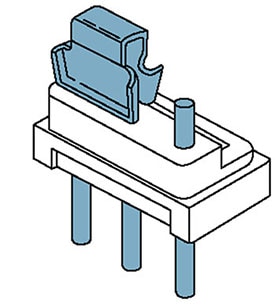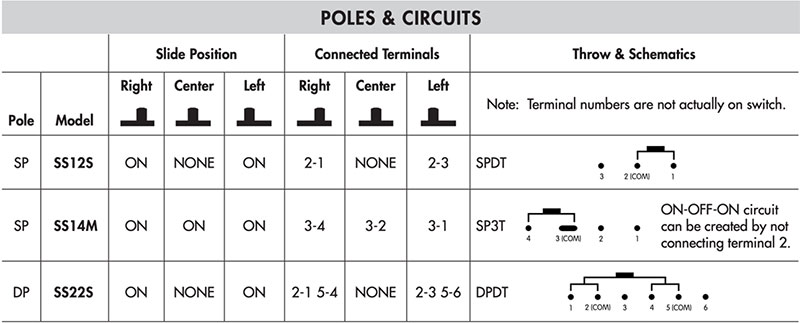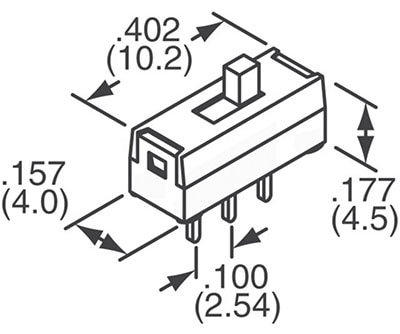Selecting and Using Ultra-Miniature Slide Switches
The first circuit you or I ever built probably contained a battery, a light, and a switch; when you closed the switch, the light came on, and when you opened the switch, the light went off. That’s how we learned the role of switches in electronic design. The key to selecting the best switch type for a design is to determine the switch's function, the type of switch needed, and the current and voltage rating required. Here, we’ll focus on slide switches used in compact designs. The target application requires ultra-miniature slide switches with compact dimensions and low profiles that permit high printed circuit board (pc board) density and close stacking.
NKK Switches offers the SS series of ultra-miniature slide switches for applications using logic level and low power switching for these requirements. The series includes top and side actuated designs with compact dimensions. They are available in a broad range of configurations, each offering smooth action with positive detent operation and enhanced contact stability. Before getting into specifics, let’s review some slide switch basics.
The basics of slide switches
Like most switch types, slide switches have the same essential components inside the housing, including a moveable contact attached to the common terminal and stationary contacts connected to the output terminals (Figure 1).
 Figure 1: Shown is a simplified internal view of an SS series ultra-miniature slide switch. (Image source: NKK Switches)
Figure 1: Shown is a simplified internal view of an SS series ultra-miniature slide switch. (Image source: NKK Switches)
The slide switch mechanism consists of a moveable contact that slides over either of the two stationary contacts. In the SS series switches, NKK Switches use sliding twin crossbar (STC) contacts that provide a highly reliable contact mechanism. The switch operation is smooth with a crisp feel, positive detent actuation, and increased contact stability. The moving contact meets the fixed contact at right angles, which reduces the area of its contact point, resulting in a more stable contact resistance. The dual crossbars pinch the stationary contacts, providing contact redundancy for better reliability. The self-wiping motion cleans the switch contacts with each actuation.
Poles, throws, and positions
Switches are identified by the number of circuits controlled by the switch and the number of contacts made in each circuit (Figure 2).
 Figure 2 : The description of circuit connections for each position of three common types of switches. (Image source: NKK Switches)
Figure 2 : The description of circuit connections for each position of three common types of switches. (Image source: NKK Switches)
The pole refers to the number of circuits controlled by the switch. A single pole (SP) switch controls only a single electrical circuit. Double pole (DP) switches control two independent circuits. The switch throw describes the number of output connections each switch pole can have. The NKK Switches SS series is available in SP and DP configurations with double throw (DT) or triple throw (3T) connections.
Examples of ultra-miniature SS series slide switches
An SPDT slide switch like the NKK Switches SS12SDP2 has a single common terminal and two output terminals (Figure 3).
 Figure 3: The SS12SDP2 has three external terminals and two slide positions. The center terminal is the common (pin 2), and the right (1) and left (3) are the two output terminal pins. (Image source: NKK Switches)
Figure 3: The SS12SDP2 has three external terminals and two slide positions. The center terminal is the common (pin 2), and the right (1) and left (3) are the two output terminal pins. (Image source: NKK Switches)
For example, this SPDT switch has a single pole and two different switch output options.
Referring to the SPDT row in Figure 2, the common terminal (pin 2 in the center) is connected to the right-hand (pin 1) output when the slide is in the right-hand position. Similarly, when the slider is in the left-hand position (as shown in Figure 3), the common terminal is connected to the left-hand (pin 3) output terminal.
Contact timing refers to the order in which the slider connects adjacent contacts. The SS12SDP2 is a make-before-break (MBB) or a shorting contact type of switch. The common and output pins are briefly connected when the slider changes position. The alternative contact timing is a break-before-make (BBM) or a non-shorting contact type of switch. The slider in a BBM switch does not connect the output terminals while being switched. A BBM switch would be required to prevent a short circuit if an SPDT switch connects a common line between two different voltage sources.
The SS12SDP2 is rated to handle low power levels up to 100 milliamperes (mA) at up to 30 volts DC (VDC). Power levels greater than 0.4 volt-amperes (VA) use silver plating on the contacting surfaces and have a specified contact resistance of 20 milliohms (mΩ) or less.
The SS12SDP2 is an ultra-miniature slide switch with a very compact design (Figure 4).
 Figure 4: The SS12SDP2 is designed to fit on a 0.1 inch hole grid. (Image source: NKK Switches)
Figure 4: The SS12SDP2 is designed to fit on a 0.1 inch hole grid. (Image source: NKK Switches)
The dimensions of the switch are 0.402 inches (in.) (10.2 millimeters (mm)) long by 0.157 in. (4 mm) wide by 0.177 in. (4.5 mm) high. They are clearly earning the ultra-miniature title. The contact pins are spaced at 0.100 in. (2.54 mm) to fit this common pc board hole layout grid.
The NKK Switches SS22SDH4 is a DPDT slide switch with a right-angle mount, so the slide is on the side of the switch body and is described as a side-actuated switch (Figure 5).
 Figure 5: The SS22SDH4 is a right-angle DPDT ultra-miniature slide switch with two common terminals and two output contacts per common. (Image source: NKK Switches)
Figure 5: The SS22SDH4 is a right-angle DPDT ultra-miniature slide switch with two common terminals and two output contacts per common. (Image source: NKK Switches)
Referring to the DPDT row in Figure 2, the DP switch has two common terminals, each with two possible output connections. Like the SS12SDP2, the SS22SDH4 is an MBB switch.
The SS22SDH4 is rated to handle low-power logic levels below 0.4 VA at 28 volts AC (VAC) or DC (VDC). This low-power logic level operation is called a dry circuit; there is no arcing when the contacts open or close at these low voltage levels. This means that the tarnish on the contacts is not burned away and can build up, increasing the contact resistance. Gold plating on the contacting surfaces is used for this class of service with a rated contact resistance of 40 mΩ or less.
The dimensions of the switch are 0.402 in. (10.2 mm) long by 0.257 in. (6.54 mm) wide by 0.197 in. (5 mm) high. The contact pins are also spaced to fit the common 0.100 in. (2.54 mm) pc board hole spacing grid.
The NKK Switches SS14MDP2 is an SP3T BBM switch. It has a single common contact and three output contacts (Figure 6).
 Figure 6: The SP3T switch is a top actuated switch with three slide positions, allowing the common to connect individually with each of the three output contacts. (Image source: NKK Switches)
Figure 6: The SP3T switch is a top actuated switch with three slide positions, allowing the common to connect individually with each of the three output contacts. (Image source: NKK Switches)
This SP3T switch has three slide positions. In the center position shown in Figure 6, terminals 3 and 2 are connected. In the leftmost position, terminal 1 is connected to the common terminal 3, and in the rightmost position, terminals 3 and 4 are connected. As a BBM switch, when the slider is moved, contacts with the current terminal pair are broken before the next connection is established.
The SS14MDP2 is rated to handle 100 mA at 30 VDC using silver plating contact surfaces, with a contact resistance of 20 mΩ or less.
The dimensions of the switch are 0.622 in. (15.8 mm) long by 0.157 in. (4 mm) wide by 0.177 in. (4.5 mm) high. The contact pins are also spaced to fit the common 0.100 (2.54 mm) in. pc board hole spacing grid.
Our final example is the NKK Switches SS12SBP2, an SPDT slide switch that differs from the other switches in that the terminals are spaced using the 2 mm (0.079 in.) metric hole spacing. Except for the terminal spacing, it has the same specifications and physical dimensions as the SS12SDP2.
All SS series switches discussed here have a rated mechanical and electrical lifetime of 10,000 operations. They operate over a temperature range of -15° to 60°C and feature insert-molded terminals to lock out flux, solvents, and other unwanted contaminants.
Conclusion
NKK Switches’ SS series are ultra-miniature slide switches offering compact dimensions for high-density pc board mounting and stacking. Their STC mechanism provides the benefit of smoother action with positive detent reaction and high contact stability.

Have questions or comments? Continue the conversation on TechForum, DigiKey's online community and technical resource.
Visit TechForum









